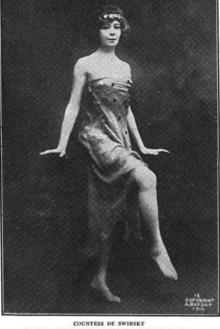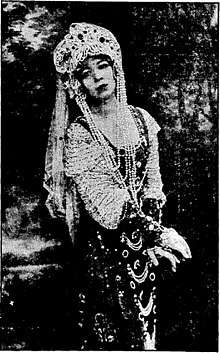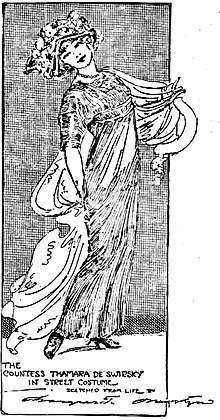Thamara de Swirsky
Thamara de Swirsky (October 17, 1888 — December 24, 1961), sometimes seen as Tamara de Svirsky, Thamara Swirskaya, or Countess de Swirsky, was a Russian-born dancer, known for dancing barefoot.

Early life
Thamara de Swirsky was born in St. Petersburg[1] into a prosperous Russian family. She studied piano in Paris and Munich, and dance in St. Petersburg.[2]
Her claim on the title "Countess" was disputed. Her mother, Zenaide de Podwissotski, may have been a medical doctor in Paris before accompanying Thamara to the United States.[3]
Career
De Swirsky, publicized in 1911 as having the "most musical body in the world",[4] "created a sensation" in the United States with her barefoot dancing.[5] Reviewers assured (or warned) readers that, while her feet were bare, she did not dance nude.[6] "Her costumes are triumphs of sartorial amplitude," declared one disappointed critic. "They leave everything to the imagination."[7] She also performed a "bat dance" with billowing sheer fabric wings.[8][9] She was the last advertised performer to appear at the Coliseum Garden Theatre in Raton, New Mexico, before it was destroyed in a 1911 fire.[10]

Thamara de Swirsky also played piano as part of some of her performances.[11] "Her style of dancing is her own," explained one Los Angeles reporter.[12] Beyond the vaudeville stage, at the Metropolitan Opera[13] she appeared as a dancer in Orfeo ed Euridice and Zar und Zimmermann, both in 1909.[14] In January 1910 she danced in Delibes' Lakmé with the Boston Opera, at English's Opera House.[15] In 1912 she performed a version of her dances in a short silent film[16] for Independent Moving Pictures.[17] In 1913 she was part of an advertising campaign for Seduction perfume.[18]
Her opinions, whims, and demands made news.[19] She smoked cigars and cigarettes.[20] She was said to have insured each of her toes for $10,000 in 1910.[21] In 1914, she was a member of Anna Pavlova's company, and her pleas for a more humid New York hotel room were reported in the New York Times.[22] Italian artist Piero Tozzi painted a portrait of de Swirsky, titled "His Flame of Life", when she turned away his romantic interest.[23][24]
During World War I she performed in New York, combining dance and "dramatic art".[25] In 1919 she appeared in a silent film, The Mad Woman, made by the Stage Women's War Relief Fund.[26][27]
In 1910, John Jacob Astor bought 25 seats for one of her concerts in Newport, Rhode Island, and sat by himself in the center to watch her performance.[28]
Personal life

In 1933 there were reports that Swirskaya was engaged to marry twice-widowed New York lawyer Frederick G. Fischer and that his family committed him to an asylum to prevent the match.[29][30]
Thamara de Swirsky professed particular love for Los Angeles as early as 1910, recalling that "I knew when I first touched foot to your soil that here I would find the warmth and the glow which would call out the best that is in me."[31] She settled in Los Angeles after her dance career; she taught and played piano for a living. She died there in 1961, weeks after she was badly injured in a traffic accident during a storm,[32] aged 73 years.[33]
There is a statuette of Thamara de Swirsky in a dance pose, by Paolo Troubetzkoy, in the collection of the Getty Museum. Her unpublished memoirs have also been discovered in recent years.[34]
References
- Harry Prescott Hanaford, Dixie Hines, eds. Who's who in Music and Drama (H. P. Hanaford 1914): 95.
- Rudolph Aronson, Theatrical and Musical Memoirs (McBride Nast 1913): 212-214.
- "Is She Really a Russian Noble?" Town Talk (November 12, 1910): 13.
- "Countess Who Has Most Musical Body in World" Montrose Daily Press (May 4, 1911): 4. via Colorado Historic Newspapers Collection
- "Thamara de Swirsky, Russian Countess Who Will Appear in Novel Barefoot Dance in Auditorium" Los Angeles Herald (November 13, 1910): III7. via California Digital Newspaper Collection
- Andrew L. Erdman, Blue Vaudeville: Sex, Morals and the Mass Marketing of Amusement, 1895–1915 (McFarland 2007): 104. ISBN 9781476613291
- Edward F. O'Day, "Thamara de Swirsky Disappointed" San Francisco Daily Times (November 12, 1910): 8.
- Shaemas O'Sheel, "On with the Dance" Forum (February 1911): 195.
- Hrabina Thamara de Swirsky (1888-1961), tancerka, tańcząca "Fledermauss valse" (ujęcie całej postaci), Muzeum Narodowe w Warszawie.
- F. Stanley, The Grant That Maxwell Bought (Sunstone Press 2008): 169. ISBN 9780865346529
- "De Swirsky Seen in Dances" Boston Globe (October 11, 1911): 5.
- "Tantalizing Thamara" Los Angeles Times (November 5, 1910): I13.
- George Dorris, "Dance and the New York Opera War, 1906-1912" Dance Chronicle 32(2)(2009): 210.
- Gerald Fitzgerald, ed., Annals of the Metropolitan Opera: The Complete Chronicle of Performances and Artists (Springer 2016): 224/4C. ISBN 9781349119769
- "Thamara de Swirsky, the Unadorned Russian Dancer" Indianapolis Medical Journal (February 15, 1910): 67.
- Classical Dances by Countess Thamara de Swirsky (1912).
- "Notes of the Week" The Moving Picture News (February 24, 1912): 25.
- Verbinina, "Ads for Séduction perfume by Gellé frères (part 2)" Verbinina (July 3, 2014).
- "Frown Too Much and Wear Corsets" Times Dispatch (August 21, 1910): 31. via Newspapers.com

- "The Knave" Oakland Tribune (June 9, 1912): 26. via Newspapers.com

- "Each Pink Toe, Ten Thousand Dollars" Los Angeles Times (November 16, 1910): II1.
- "Asked for Damp Room" New York Times (November 1, 1914): C4.
- "Eyes Show Russia's Sorrow" Los Angeles Times (January 7, 1911): II1.
- "Will Countess Wed Painter?" Los Angeles Times (December 5, 1910): I18.
- "Thamara Swirskaya to Dance on Thursday" New-York Tribune (January 13, 1918): 35. via Newspapers.com

- "When Broadway Favorites Saw Themselves as Others See Them" Theatre Magazine (March 1919): 183.
- Margaret McIvor-Tyndall, "What Women of the Theatre are Doing for Uncle Sam" National Service (May 1919): 285.
- "Countess de Swirsky Tells Marguerite Martyn," St. Louis Post-Dispatch, April 23, 1911, image 1
- "Aids Lawyer Fiance" Salem News (October 3, 1933): 5. via Newspapers.com

- "Dragged the Rich, Aristocratic Old Lawyer to an Asylum as He Was to Wed the 'Perfect Body' Danseuse" Atlanta Constitution (April 15, 1934): SM4.
- "Passion of Art Drives Her On" Los Angeles Times (November 22, 1910): II6.
- "Storm Figures in 7 Deaths, 200 Accidents" Los Angeles Times (December 3, 1961): A.
- "Rites Planned for Tamara Swirskaya" Los Angeles Times (December 28, 1961): B11.
- Anne-Lise Desmas, "The Dancer Statuette by Paolo Troubetzkoy and the Incredible Life of Countess Thamara Swirskaya" Getty Center (February 2, 2014).
External links
| Wikimedia Commons has media related to Thamara de Swirsky. |
- Thamara de Swirsky on IMDb.
- Photographs of Thamara de Swirsky in the Jerome Robbins Dance Division Photograph Files, New York Public Library.
- Photograph of Thamara de Swirsky in the George Grantham Bain Collection, Library of Congress.
- Photograph of Thamara de Swirsky in an Egyptian-inspired costume and pose, from the Muzeum Narodowe w Warszawie.
- Photographs of Tamara Swirskaya by Bassano Ltd, in the collection of the National Portrait Gallery.